
In 2024, How To Do Xiaomi Redmi K70E Screen Sharing | Dr.fone

How To Do Xiaomi Redmi K70E Screen Sharing
Smartphones by Xiaomi Redmi K70E are rich in functionality and offer multiple benefits to users. However, do we ever wonder about using screen share in Xiaomi Redmi K70E ?
Whether there is a need to show unique clicks or videos on a bigger screen or want to stream amazing content on big TVs or computers, we must know how to screen share on a Xiaomi Redmi K70E phone. It becomes a lot easier to cater to a big audience with big screens.
So today, let us go through a detailed guide on **how to screen share in Xiaomi Redmi K70E ** to smart TVs and computers.
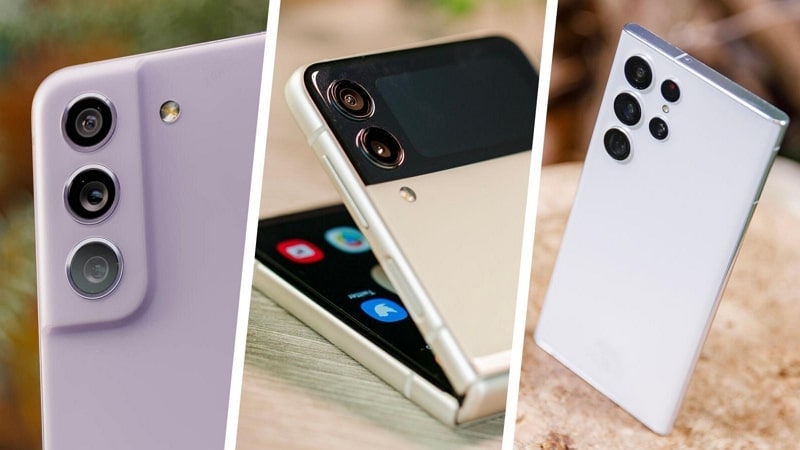
Part 1: Does Screen Sharing Use Bluetooth?
Bluetooth is not used for screen sharing as it does not have the bandwidth required to stream heavy media. Although it is commonly used for wireless data transfer, it is not suited for screen sharing. A major reason behind this is the slowness of Bluetooth, as its maximum speed for data sharing is up to 50MB/s. That makes it unreliable for screen sharing, making Wi-Fi the default choice.
Part 2: How to Share Screen From Xiaomi Redmi K70E Phone to Xiaomi TV Using Smart View?
Samsung Smart View is a feature in Xiaomi Redmi K70E devices that allows you to **screen share on Xiaomi Redmi K70E ** Smart TV. First introduced as an app, it is now an in-built feature of One UI.
When using the Smart View feature, you can share videos, photos, documents, games, and other things on your Xiaomi Redmi K70E device to your Xiaomi TV. The Smart View app allows you to use your Xiaomi Redmi K70E device as a virtual remote to control your Smart TV.
Requirements for Smart View App
The Xiaomi Redmi K70E Smart View app was introduced in 2011 to allow Xiaomi Redmi K70E users to share their device’s screen with Xiaomi TVs. Although it was discontinued on 05 October 2020 and replaced with Smart Things, its existing user base was not disturbed.
If they were already using the Smart View app or downloaded it before discontinuation, they can use it as long as they don’t uninstall it. These are the minimum requirements to use Smart View App on a device:
Android: It can be used on Android devices with Android OS 4.1 or above.
Samsung Smart TVs
All the Samsung Smart TVs after 2015 are compatible with Samsung Smart View. Below is the list of older Xiaomi TV models that offer Smart View compatibility for Samsung users:
- 2011 LED D7000 and above, PDP D8000 and above.
- 2012 LED ES7500 and above, PDP E8000 and above.
- 2013 LED F4500 and above (except F9000 and above), PDP F5500 and above.
- 2014 H4500, H5500 and above (except H6003/H6103/H6153/H6201/H6203).
- 2015 J4500, J5500 and above (except J6203).
- 2016 K4300, K5300 and above.
Samsung Devices with Smart View Feature
With the introduction of One UI in Samsung devices, the Smart View was added as an in-built feature. All Samsung devices launched with One UI can use the Smart View feature to share their device’s screen with Xiaomi TV. The Samsung devices that support the Smart View feature include Galaxy S Series, Galaxy Z Series, Galaxy Note Series, Galaxy A Series, Galaxy M Series, and Galaxy F Series.
Steps for Using Smart View to Share Screen
Before explaining the steps, it is important to state that available screens and settings may change depending on your device, Smart TV, or service provider. The Smart View feature is also unavailable on all Samsung devices, and you might need to use the Smart View or Smart Things app.
Ensure that your Samsung device and Smart TV are connected to the same network, and follow these steps for screen sharing:
Step 1: After connecting your device and Smart TV to the same Wi-Fi network, open the “Quick Panel” on your Samsung device. Here, press and enable “Smart View.”
Step 2: Select your Xiaomi TV among the available devices when Smart View is enabled. Once connected, choose the content you want to share on the TV screen.
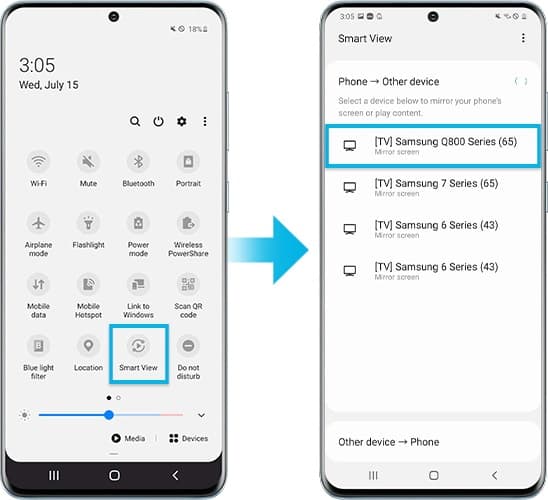
Step 3: You can select your desired content through options like My Photos, My Videos, or My Music. When the desired content is selected, you can enjoy it on a bigger screen.
Part 3: How to Share Screen From Samsung Phones to Other Smart TVs?
If your Smart TV is of another brand instead of Samsung, it is still possible to share the Samsung devices screen with your TV. Multiple tools are available online that can be used to share your Samsung device with your TV, depending on the TV brand. You can use tools like AllShare Cast, Chromecast, or Amazon Firestick.
Like Smart View, all wireless screen share tools require your Samsung device and Smart TV to be connected to the same network. Once connected, you will need to plug the respective tool’s adapter into your Smart TV, and you should be able to share your Samsung device. If your Smart TV doesn’t support Miracast, you can use AllShare Cast Wireless Hub for screen sharing.
Part 4. How to Share Screen From Samsung Phone to Computer Using Dr.Fone Air?
After learning about screen sharing to TVs, it is about sharing a Samsung phone screen with a computer. There is no need to worry, as we have a perfect wireless solution.
Dr.Fone Air is a powerful online screen mirror solution allowing screen sharing in Samsung to any computer. It can quickly mirror a Samsung phone to any web browser using a Wi-Fi connection only. Further, it is easy to download Wondershare Dr.Fone Air from its official website.
Key Features of Dr.Fone Air
- It provides great cross-platform support for screen sharing and casting. You can easily share screens from Android or iOS to Windows or Mac.
- You don’t need to give any unnecessary permissions when using Dr.Fone Air. It also doesn’t require Bluetooth or NFC for screen sharing.
- Your data during screen sharing remain protected as it doesn’t require downloading or uploading your content.
Steps of Using Dr.Fone Air for Screen Sharing
Sharing your Samsung phone screen with your Xiaomi TV using Dr.Fone Air is a simple and quick process. Your Samsung device and Xiaomi TV needs to be connected to the same Wi-Fi network. Once they are connected, follow these steps for screen sharing:
- Downloading and launching Dr.Fone Air: The first step is to download and launch Dr.Fone Air from the official website. The next step is to connect the Samsung phone and computer with the same Wi-Fi connection.
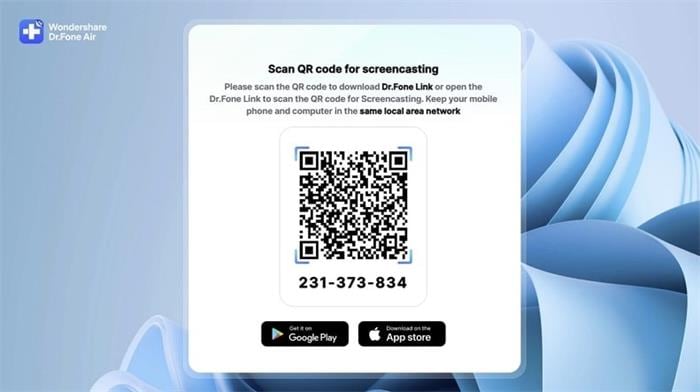
- Using QR or Cast code: The second step is to use the QR or Cast code as shown on the screen of the browser.
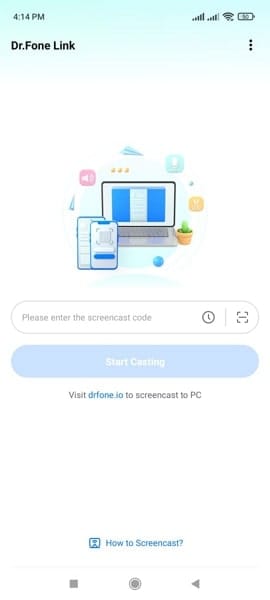
- Mirroring Samsung phone to computer: The Samsung phone will be automatically mirrored to the computer on successful scanning or code entering.

Conclusion
Hope everything is clear to our readers about the different methods to share the screen in Samsung. The detailed steps for screen sharing on Samsung phones to Xiaomi TVs and other Smart TVs make it easy for users to optimize the benefits of the big screen.
Make sure to check out is using Dr.Fone Air for sharing screens from Samsung phones to computers directly. It is a reliable, secure, and quick method to wirelessly mirror any mobile phone screen to any web browser.
Best 3 Xiaomi Redmi K70E Emulator for Mac to Run Your Wanted Android Apps
Mac OS, on the other hand, is a wonderful operating system used by Apple Inc. on it’s Mac PC and MacBook. It has a marvelous user interface and great features. It will be fantastic if we were able to use Android apps on Mac PC. Luckily, it is possible by using an emulator. In this article, we will learn about the five best Android Emulators for Mac.
Part 1. Why You Would Run Android Apps on Mac
- • To run around 1.2 million apps on Mac from Google Play Store.
- • To play tons of Android games on larger screen.
- • People, who spend a good amount of time in front of desktop, will find it more convenient if they were able to use apps like WeChat, WhatsApp, Viber, Line etc. on their Mac.
- • App developer can test their apps on the desktop before sending it to the Google Play Store for user reviewing.
- • Some Emulator supports battery and GPS widgets. So, developers can test their apps based on the battery performance and can also test how their apps will work on different geographical locations.
Part 2. Top 3 Android Emulator for Mac
1. BlueStacks
BlueStacks App Player is probably the most popular emulator for running Android apps on Mac. It is available for both Mac and Windows. It creates a virtual copy of Android OS apps on the guest OS. It uses the unique “LayerCake” technology that allows you to run android apps on your PC without any external Virtual Desktop Application. Once install user can enjoy Android games and apps such as News Feeds, Social Network on a large screen.
BlueStacks maintain an internal search manager that allows any apk, the package file format that is used to distribute and install application and middleware on any Android device, to install within it. It can be
Advantage
- • .apk files can be installed into BlueStacks from Mac simply by double clicking.
- • It can also sync between the apps on Mac and the android phone or tablet by installing BlueStacks Cloud Connect app on Android Device.
- • Apps can be launched directly from Mac dashboard.
- • No need to configure additional Internet connection as it automatically gets the Internet connection of host computer.
- • BlueStacks App Player is available for both Windows and Mac.
Disadvantage
- When running complex graphic apps it fails to respond to the input in a timely fashion.
- It does not provide any mechanism to uninstall cleanly from the host computer.
Download
- • It can be downloaded from the official website of BlueStacks . It is absolutely free.
How to use
Download BlueStacks for Mac OS X from the official website of BlueStacks and install it like any other software on your PC. Once installed, it will boot up to its Home Screen. From there you can find the installed apps, find new apps in the “Top Charts”, search apps, play games and change settings. Mouse will be the basic touch controller. To access Google Play you will have to associate a Google Account with BlueStacks.
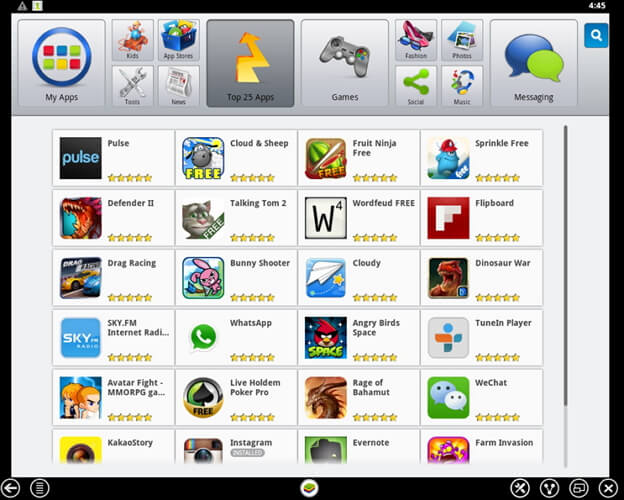
2. Genymotion
Genymotion is a fast and wonderful third party emulator that can be used to create a virtual environment for Android. It is the fastest Android emulator on the earth. It can be used to develop, test and run Android apps on Mac PC. It is available for Windows, Mac, and Linux machine. It is easy to install and can create a customized android device. You can start multiple virtual devices at the same time. It has the pixel perfect functionality so you can be precise to your UI development. By using the OpenGL acceleration it can achieve the best 3D performance. It directly commands the virtual devices sensors with Genymotion sensors. It is evolution of the Android open source project and already trusted by about 300,000 developers around the globe.
Advantage
- • Best 3D performance is achieved through OpenGL acceleration.
- • Support full screen option.
- • Can start multiple virtual devices at the same time.
- • Fully compatible with ADB.
- • Available for Mac, Windows and Linux machine.
Disadvantage
- • Require virtual Box to run Genymotion.
- • Cannot deploy Android machine offline.
Download
- Genymotion can be downloaded from the official website of Genymotion. The latest version of Genymotion is 2.2.2. You have to choose a package that meets your requirements.
How to use
- 1. Download Genymotion. You have to create an account to download it.
- 2. Open the .dmg installer. It will also install Oracle VM Virtual Box on your computer.
- 3. Move the Genymotion and Genymotion Shell to application directory.
- 4. Click the icon from Application directory and the following window will appear.
- 5. To add virtual device click on the add button.
- 6. Click on the connect button.
- 7. Enter your user name and password to connect to the Genymotion Cloud and click on the connect button. After connecting with the Genymotion cloud the following screen will appear.
- 8. Select a virtual machine and click on Next.
- 9. Give a name for the Virtual machine like below and click on Next.
- 10. Your virtual device will be now be downloaded and deployed. Click on the Finish button after successful deployment of your virtual machine.
- 11. Click on the Play button to start the new virtual machine and enjoy.

3. Andy
Andy is an open source emulator that allows developers and users to enjoy more robust apps, to experience them in multiple device environments, and to stop being constraint by the limits of device storage, screen size or separate OS. User can update their Android through Andy. It provides seamless sync between desktop and mobile device. User can use their phone as joystick while playing games.
Advantage
- • It provides a seamless sync between desktop and mobile device.
- • Enable Android OS update.
- • Enable app download from any desktop browser to Andy OS.
- • Phones can be used as joystick while playing games.
- • Unlimited storage expansion.
Disadvantage
- • Increase CPU usage.
- • Consumes a lot of physical memory.
Download
- • You can download Andy from <www.andyroid.net>.
How to Use
- 1. Download and install Andy.
- 2. Launch Andy. It will take about a minute to boot and then it should see a welcome screen.
- 3. Sign into your Google Account and complete the rest of the setup screen. You will be asked to provide your Google Account Information to 1ClickSync, the app that let’s you sync between Andy and the mobile device

Process of Screen Sharing Xiaomi Redmi K70E to PC- Detailed Steps
Currently, there are many companies where their employees work across different locations. For these teams, managing work between all members can get complex, and having to continually send files via email to all members. This can get tiring and complex to handle long term.
Comparatively, using the screen-sharing approach will help improve collaboration with multiple people.
In this context, you can use a capable remote access software like TeamViewer to share screens to PC from multiple devices, like Android-based smartphones and tablets. This helps professionals improve their teamwork, coordination, and interaction on projects, to name one benefit.
Read on to learn more about this software and how to screen share Android devices to it.
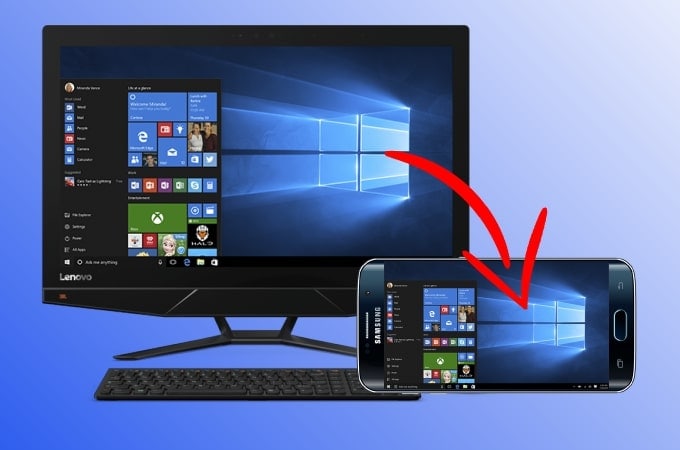
Part 1. What is TeamViewer?
TeamViewer is a remote access management platform for companies and regular people. They use it for better team activity management, especially remote teams. They can experience better work productivity when using this software, like with the screen-sharing features.
The latter allows for screen-to-screen content broadcasting that many people from varying locations. This is useful for multi-member meetings.
Key Features:
- Password protects the meetings from unauthorized access.
- Screen share to PC from different devices/apps.
- Handle around 10 video streams per remote control or meeting session.
- Set scheduled meetings.
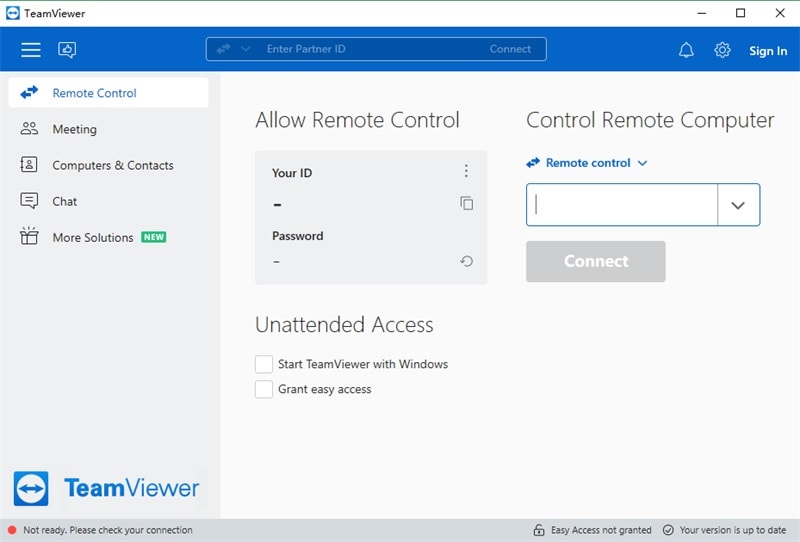
Part 2. Key Benefits of the TeamViewer Screenshare Tool
When users operate with TeamViewer to screen-share to PC, there are many advantages they can enjoy. Here are some of them, explained in points for your reference.
- Improved collaboration- Professionals in different sectors and sizes can collaborate better using the TeamViewer screen-sharing feature. Organizers can share their Android screens with different meeting participants. And then the latter can work on the documents from any location or device.
- Streamlined productivity- TeamViewer users can easily share their data, like documents and presentations, with different users in real-time for discussion. This is instead of the conventional method of individually emailing them for review.
- Better onboarding and tutoring- Professionals using TeamViewer can do onboarding and training processes. For example, by sharing the screen with participants, they can visually show how processes or software types work.
- More robust Security- TeamViewer runs with AES (265-bit) encryption for sessions with RSA public/private key exchange support. This assures a safe and more controlled screen-sharing experience compared to other alternatives.
To correctly share the screen to PC, TeamViewer users can access it via Android smartphones or tablets. Here are the steps to share the screen with this platform.
Step 1: On the Android device, visit Google Play Store > install TeamViewer Host .
Step 2: If you do not have an account here, create a new one or log in.
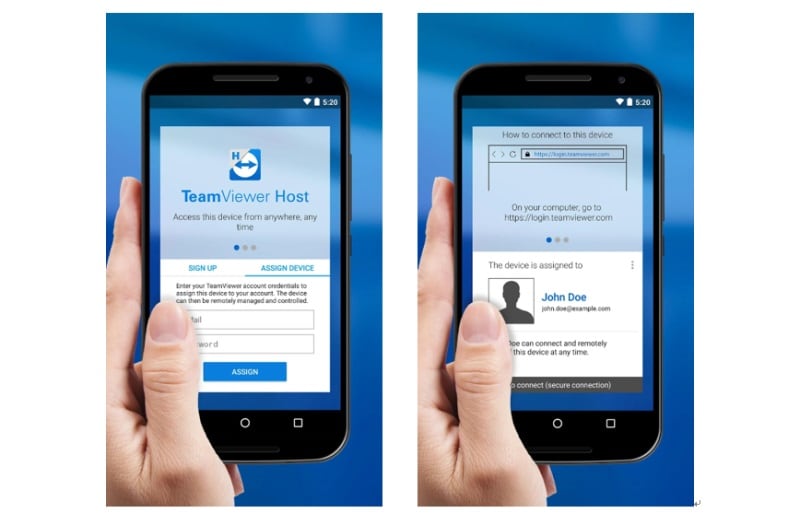
Step 3: On the PC (Windows/Linux/macOS), visit the login page via any preferred browser > Sign into the account that you created.
Step 4: A list of synced devices will appear. Tap the Connect button beside the Android device you share the screen from.
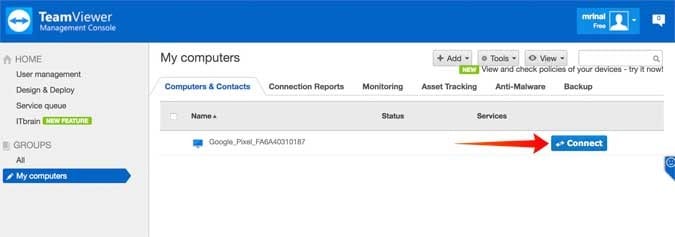
Step 5: The “Launch the TeamViewer” prompt will appear > Press OK. Before this, download and launch the app on your PC.
Step 6: The TeamViewer application will appear on your PC in a new window.
Step 7: Give the software permission for TeamViewer screen sharing on the Android smartphone. This will come up as a prompt “Host will start capturing everything that’s displayed on your screen” on your phone.
Step 8: Press Start Now > Don’t Show Again.

Step 9: The Android device screen will start sharing on the PC.
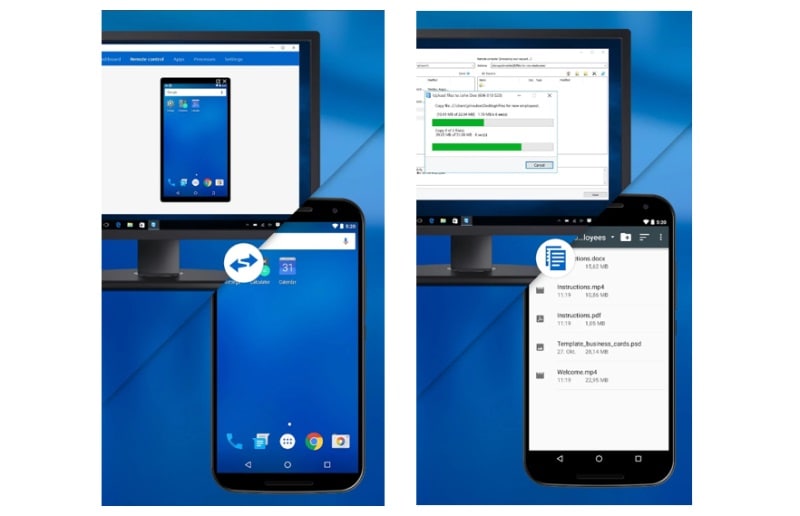
Part 4. TeamViewer Reviews - Pros & Cons & Ratings
For screen sharing to PC, many companies globally turn to TeamViewer as their primary tool. Here’s the average rating of the software from users’ feedback.
Rating: 4.5 out of 5 (G2 )
Different users from companies have hailed the best user experience from this software- here are some of these reviews.
| User | Reviews |
|---|---|
| Eileen Currier | “This is a very User-Friendly software that allows someone to easily connect and fix problems.” |
| Alexandre Lundgren | “I am just impressed by the quality of TeamViewer. It is easy to learn and so powerful.” |
You will see certain advantages and disadvantages of this software when you use it to screen share to a PC.
Pros:
- Users can access it without getting an account as well.
- Easy functionality.
- Three concurrent sessions can also work with the single-user TeamViewer Remote Access plan, which costs less.
Cons:
- The free plan has limited benefits.
- Business users must pay high amounts to get a license for entire teams.
Part 5. Better Alternative for the TeamViewer Screenshare Tool
TeamViewer is helpful for screen sharing, but it is slightly complex. Besides, screen mirroring is a better alternative. During this, you can better control the elements on the screen or in-person meetings. On that note, Wondershare Dr.Fone Air is helpful software.
It is simple to use, and the software allows smooth wireless screen mirroring from Android and iOS smartphones onto Mac or Windows PC. The solution is free as well.
Price: Free
Features:
- Cross-platform.
- Easy and secure screen mirroring with controlled authorization.
- No need to attach cables or Bluetooth- it works wirelessly.
- Control screen elements like rotating screen, zoom in/zoom out, etc.
How to use it for Android-to-PC screen mirroring?
Download the Dr.Fone Link App on your Android smartphone.
Go to the official site on the PC via your preferred browser.
Connect the Xiaomi Redmi K70E devices to the same network.
Sync the Xiaomi Redmi K70E devices using the QR code/nine-digit Cast Code.
Finally, the screen mirroring process will begin.
Conclusion
TeamViewer is one of the best solutions users can use for professional remote team collaboration. The screen-sharing functionality is helpful for broadcasting content from an Android phone to a PC. For a more effortless experience, screen mirroring with Dr.Fone Air software works. So, you should consider that as well.
Also read:
- [New] Mastering Zip-to-Srt Transform Subtitled Content Swiftly
- [Updated] 2024 Approved Recovering a Stopped-Up Link to Your OBS Cam
- [Updated] 2024 Approved Unveiled Top 10 Superior GoPro Housing Options
- Hard Resetting an Honor Play 8T Device Made Easy | Dr.fone
- How to Lock Apps on Vivo Y78 5G to Protect Your Individual Information
- How to Mirror Apple iPhone 6s to Other iPhone? | Dr.fone
- How to Mirror Your Itel A60s Screen to PC with Chromecast | Dr.fone
- In 2024, 3 Facts You Need to Know about Screen Mirroring Realme 11 5G | Dr.fone
- In 2024, About Sony Xperia 1 V FRP Bypass
- In 2024, How to Mirror Your Nokia C22 Screen to PC with Chromecast | Dr.fone
- In 2024, Process of Screen Sharing Samsung Galaxy A34 5G to PC- Detailed Steps | Dr.fone
- In 2024, Revolutionizing the Opening Experience
- New The Ultimate Guide to Implementing Audio Keyframes Using Adobe Premiere Pro for Mac Users
- Title: In 2024, How To Do Xiaomi Redmi K70E Screen Sharing | Dr.fone
- Author: Seraphina
- Created at : 2025-01-29 23:30:05
- Updated at : 2025-01-30 18:49:06
- Link: https://screen-mirror.techidaily.com/in-2024-how-to-do-xiaomi-redmi-k70e-screen-sharing-drfone-by-drfone-android/
- License: This work is licensed under CC BY-NC-SA 4.0.
